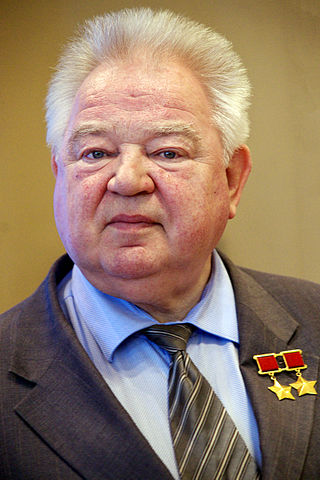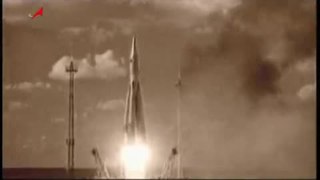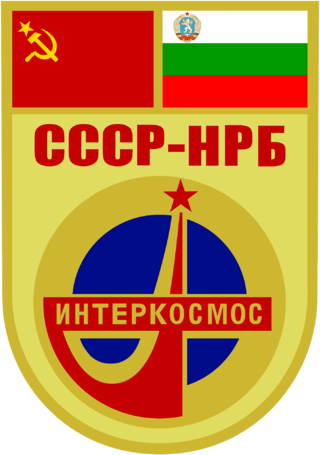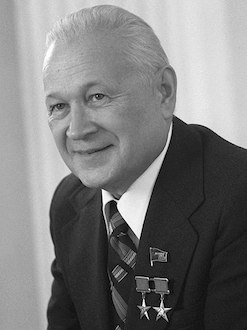Related Research Articles

A space station is a spacecraft capable of supporting a human crew in orbit for an extended period of time and is therefore a type of space habitat. It lacks major propulsion or landing systems. An orbital station or an orbital space station is an artificial satellite. Stations must have docking ports to allow other spacecraft to dock to transfer crew and supplies. The purpose of maintaining an orbital outpost varies depending on the program. Space stations have most often been launched for scientific purposes, but military launches have also occurred.

The Salyut programme was the first space station programme, undertaken by the Soviet Union. It involved a series of four crewed scientific research space stations and two crewed military reconnaissance space stations over a period of 15 years, from 1971 to 1986. Two other Salyut launches failed. In one respect, Salyut had the task of carrying out long-term research into the problems of living in space and a variety of astronomical, biological and Earth-resources experiments, and on the other hand the USSR used this civilian programme as a cover for the highly secretive military Almaz stations, which flew under the Salyut designation. Salyut 1, the first station in the programme, became the world's first crewed space station.

The Space Race was a 20th-century competition between two Cold War rivals, the United States and the Soviet Union, to achieve superior spaceflight capability. It had its origins in the ballistic missile-based nuclear arms race between the two nations following World War II. The technological advantage demonstrated by spaceflight achievement was seen as necessary for national security, and became part of the symbolism and ideology of the time. The Space Race brought pioneering launches of artificial satellites, robotic space probes to the Moon, Venus, and Mars, and human spaceflight in low Earth orbit and ultimately to the Moon.

PAO S. P. Korolev Rocket and Space Corporation Energia, also known as RSC Energia, is a Russian manufacturer of spacecraft and space station components. The company is the prime developer and contractor of the Russian crewed spaceflight program; it also owns a majority of Sea Launch. Its name is derived from Sergei Korolev, the first chief of its design bureau, and the Russian word for energy.

Konstantin Petrovich Feoktistov was a Soviet cosmonaut and an eminent space engineer. As a cosmonaut Feoktistov flew on Voskhod 1, the first spacecraft to carry three crew members. Feoktistov also wrote several books on space technology and exploration. The Feoktistov crater on the far side of the Moon is named in his honor.

Salyut 1 (DOS-1) was the world's first space station launched into low Earth orbit by the Soviet Union on April 19, 1971. The Salyut program followed this with five more successful launches of seven more stations. The final module of the program, Zvezda (DOS-8), became the core of the Russian segment of the International Space Station and remains in orbit.

Salyut 2 (OPS-1) was a Soviet space station which was launched in 1973 as part of the Salyut programme. It was the first Almaz military space station to fly. Within two weeks of its launch, the station had lost attitude control and depressurized, leaving it unusable. Its orbit decayed and it re-entered the atmosphere on 28 May 1973, without any crews having visited it.

Salyut 3 was a Soviet space station launched on 25 June 1974. It was the second Almaz military space station, and the first such station to be launched successfully. It was included in the Salyut program to disguise its true military nature. Due to the military nature of the station, the Soviet Union was reluctant to release information about its design, and about the missions relating to the station.

Salyut 6, DOS-5, was a Soviet orbital space station, the eighth station of the Salyut programme. It was launched on 29 September 1977 by a Proton rocket. Salyut 6 was the first space station to receive large numbers of crewed and uncrewed spacecraft for human habitation, crew transfer, international participation and resupply, establishing precedents for station life and operations which were enhanced on Mir and the International Space Station.

Salyut 7 was a space station in low Earth orbit from April 1982 to February 1991. It was first crewed in May 1982 with two crew via Soyuz T-5, and last visited in June 1986, by Soyuz T-15. Various crew and modules were used over its lifetime, including 12 crewed and 15 uncrewed launches in total. Supporting spacecraft included the Soyuz T, Progress, and TKS spacecraft.

Georgy Mikhaylovich Grechko was a Soviet cosmonaut. He flew to space on three missions, each bound for rendezvous with a different Salyut space station. Soyuz 17 was the first crewed vehicle to visit Salyut 4, Soyuz 26 was the first crewed vehicle to visit Salyut 6, and Soyuz T-14 visited Salyut 7. During the latter mission, Grechko helped to relieve the crew of Soyuz T-13, who had repaired damage to the station.

The Almaz program was a highly secret Soviet military space station program, begun in the early 1960s.

STS-71 was the third mission of the US/Russian Shuttle-Mir Program and the first Space Shuttle docking to Russian space station Mir. It started on June 27, 1995, with the launch of Space Shuttle Atlantis from launchpad 39A at the Kennedy Space Center in Florida. The Shuttle delivered a relief crew of two cosmonauts Anatoly Solovyev and Nikolai Budarin to the station and recovered Increment astronaut Norman Thagard. Atlantis returned to Earth on July 7 with a crew of eight. It was the first of seven straight missions to Mir flown by Atlantis, and the second Shuttle mission to land with an eight-person crew after STS-61-A in 1985.

Gennady Mikhailovich Strekalov was an engineer, cosmonaut, and administrator at Russian aerospace firm RSC Energia. He flew into space five times and lived aboard the Salyut 6, Salyut 7, and Mir space stations, spending over 268 days in space. The catastrophic explosion of a Soyuz rocket in 1983 led to him being one of only four people to use a launch escape system. He was decorated twice as Hero of the Soviet Union and received the Ashoka Chakra from India.

The Soviet space program was the national space program of the former Union of Soviet Socialist Republics (USSR), active from 1955 until the dissolution of the Soviet Union in 1991.

Soyuz 33 was an April, 1979, Soviet crewed space flight to the Salyut 6 space station. It was the ninth mission to the orbiting facility, but an engine failure forced the mission to be aborted, and the crew had to return to Earth before docking with the station. It was the first failure of a Soyuz engine during orbital operations.

Soyuz T-15 was a crewed mission to the Mir and Salyut 7 space stations and was part of the Soyuz programme. It marked the final flight of the Soyuz-T spacecraft, the third generation Soyuz spacecraft, which had been in service for seven years from 1979 to 1986. This mission marked the first time that a spacecraft visited, and docked with, two space stations in the same mission.

Vladimir Nikolayevich Chelomey or Chelomei was a Soviet engineer and designer in missile program of the former Soviet Union. He invented the first Soviet pulse jet engine and was responsible for the development of the world's first anti-ship cruise missiles and ICBM program of Soviet Union such as the UR-100, UR-200, UR-500 and UR-700.

Mir, DOS-7, was the first module of the Soviet/Russian Mir space station complex, in low Earth orbit from 1986 to 2001. Generally referred to as either the core module or base block, the module was launched on 20 February 1986 on a Proton-K rocket from LC-200/39 at the Baikonur Cosmodrome. The spacecraft was generally similar in design to the two previous Soviet orbital stations, Salyut 6 and Salyut 7, however possessed a revolutionary addition in the form of a multiple docking node at the forward end of the module. This, in addition to the docking port at the rear of the spacecraft, allowed five additional modules to be docked directly to DOS-7, greatly expanding the station's capabilities.
References
- ↑ Pesahovitch, Ivgeny; Olga Pollack (August 24, 1997). "The frail humanity of Mir". The Jerusalem Post . p. 6.
The novelist William Gibson said in a recent interview that the best science fiction of the 1990s is on CNN news. Gibson and Bruce Sterling wrote a story in the 1980s called Red Star, Winter Orbit, set in a dilapidated Soviet space station slowly falling apart. As usual, the science-fiction writers, the real prophets of our age, were ahead of the launch of Mir, as well as of its current decay. Yet Gibson admitted it would have been hard for him "to beat that garbage-module slamming into Mir! ... Looking back, I can see that we didn't go nearly far enough [in the Red Star story.]"
- 1 2 Rapatzikou, Tatiana (2004). Gothic Motifs in the Fiction of William Gibson. Amsterdam: Rodopi. pp. 63–64. ISBN 90-420-1761-9.